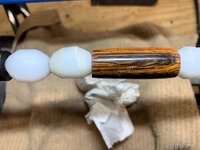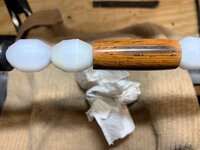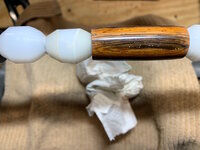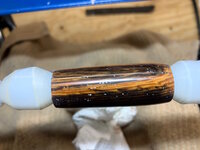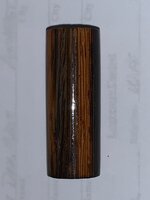Shooter-55
Member
It's making me crazy. Get the blank to perfect sanded finish, smooth as glass, then try to apply CA and screw it up causing white embedded streaks. Here is what I've tried to do:
1. Sand to at least 400 up to 600 grit
2. Blow off blank
3. Clean with DNA
4. 3 coats sanding sealer (1/2 SS - 1/2 Laq thinner) Have done with and without.
5. Apply 3 coats Thin CA
6. Apply 6-9 coats Med CA
7. Sand up to 600 again to smooth finish.
This is where my issues are. After sanding, blowing off and cleaning with DNA, embedded streaks appear in what I think are crevices in the grain. At this point, I stop and don't go to the MM. I just sand down to bare blank and apply Pens Plus and get a decent, (although not as mirror-like) acceptable finish. I have tried many suggested processes as shown on the forum, but am at wits end on this.
Heres some questions:
1. When applying CA on a porous blank with visible "crevices", will enough coats fill those in or will it just build up the ridges and they are still there. If it does fill, am I not putting enough CA on?
2. When used, is Sanding Sealer exacerbation my issue?
3. When sanding after applying CA, can the lathe speed actually "melt" the CA and cause this. If so, what speed should I be sanding with?
4. Should I be using Acetone instead of DNA?
5. Does lathe speed contribute to the tear-out which makes this occur?
I realize that many of you have many years of experience, and I'm just starting out, so don't judge me too harshly if I am totally missing something. I want to be a sponge and absorb any advice or suggestions as to doing this and get the best possible finish I can do.
I appreciate any help provided.
Tim
1. Sand to at least 400 up to 600 grit
2. Blow off blank
3. Clean with DNA
4. 3 coats sanding sealer (1/2 SS - 1/2 Laq thinner) Have done with and without.
5. Apply 3 coats Thin CA
6. Apply 6-9 coats Med CA
7. Sand up to 600 again to smooth finish.
This is where my issues are. After sanding, blowing off and cleaning with DNA, embedded streaks appear in what I think are crevices in the grain. At this point, I stop and don't go to the MM. I just sand down to bare blank and apply Pens Plus and get a decent, (although not as mirror-like) acceptable finish. I have tried many suggested processes as shown on the forum, but am at wits end on this.
Heres some questions:
1. When applying CA on a porous blank with visible "crevices", will enough coats fill those in or will it just build up the ridges and they are still there. If it does fill, am I not putting enough CA on?
2. When used, is Sanding Sealer exacerbation my issue?
3. When sanding after applying CA, can the lathe speed actually "melt" the CA and cause this. If so, what speed should I be sanding with?
4. Should I be using Acetone instead of DNA?
5. Does lathe speed contribute to the tear-out which makes this occur?
I realize that many of you have many years of experience, and I'm just starting out, so don't judge me too harshly if I am totally missing something. I want to be a sponge and absorb any advice or suggestions as to doing this and get the best possible finish I can do.
I appreciate any help provided.
Tim

